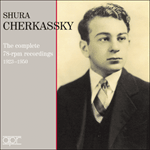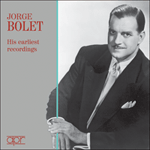
Welcome to Hyperion Records, a British classical label devoted to presenting high-quality recordings of music of all styles and from all periods from the twelfth century to the twenty-first.
Hyperion offers both CDs, and downloads in a number of formats. The site is also available in several languages.
Please use the dropdown buttons to set your preferred options, or use the checkbox to accept the defaults.

As with those composers, No 2, Andantino, is in the relative minor key. It is designed to increase finger independence in an original and beautiful way. Different notes are to be emphasized, in repeated chords, creating an undulating melodic line. Saint-Saëns’ comments about Stamaty’s hand-guide training resonate here: ‘Tone quality by the finger only, a precious expedient that has become rare in our days.’
The third of the set is the Prélude et Fugue in F minor, slightly reminiscent of Mendelssohn’s preludes and fugues, and encouraging a non-legato touch. The Prélude is fiendishly difficult and toccata-like in its groups of repeated thirds, alternating between the hands. Saint-Saëns had a personal knack for this sort of thing and used it in other places as well—for example, the two piano Variations on a Theme of Beethoven, Op 35. The Fugue is three-voiced with a fairly chromatic subject which achieves its climax in leaping octaves.
Then to the relative major key for the fourth piece, Étude de rythme, which prettily and persistently explores a two-against-three rhythm, either in the one hand, or between the two.
No 5 is another Prélude et Fugue, with related themes in A major. Accompanying double-note tremolos suggest a vaguely impressionistic blur in the Prélude and recall the double-notes of the first étude. This is far more graceful in intent, though, and leads to a slightly academic four-voice Fugue. What a brilliant contrast, therefore, to the ensuing étude, En forme de Valse, one of the delights of the French repertoire and a favourite in the concert hall. This piece calls for the jeu perlé style of playing at which Saint-Saëns so excelled—characterized by glittering precision, with fast, clear, shallow-keyed articulation and a suave elegance. It is charming and pianistically mischievous, with its runs in thirds, sixths and octaves and its caricature of the salon showpiece.
from notes by Piers Lane © 1998
Comme chez ces compositeurs, l’étude no2, Andantino, est en relatif mineur. Elle est conçue pour faciliter l’indépendance des doigts et y parvient de manière originale et harmonieuse. Différentes notes sont tour à tour accentuées sur des accords répétés pour créer une ligne mélodique ondulante. Les remarques de Saint-Saëns sur le manuel de doigté de Stamaty trouvent ici leur écho: «Atteindre la bonne tonalité par le seul doigté est un expédient précieux, mais qui se fait rare de nos jours.»
La troisième pièce, Prélude et Fugue, en fa mineur, rappelle vaguement les préludes et fugues de Mendelssohn et appelle une exécution non liée. Le Prélude est extrêmement difficile à interpréter et ses groupes de tierces répétées à mains alternées l’apparentent à une toccata. Saint-Saëns avait une prédilection pour ce genre de subtilités, que l’on retrouve ailleurs dans son œuvre, par exemple dans les Variations pour deux pianos autour d’un thème de Beethoven, op. 35. La Fugue est à trois voix; son sujet, chromatique en grande partie, atteint son apogée par octaves.
On passe ensuite à la quatrième pièce, Étude de rythme, en relatif majeur, qui exploite de manière plaisante et avec persistance une mesure à trois-deux et se joue en alternance d’une main et des deux.
La cinquième pièce est un autre Prélude et Fugue, avec des thèmes proches, en la majeur. Dans le Prélude, des trémolos en double notes produisent un flou vaguement impressionniste et rappellent les double notes de la première étude. Ce prélude est cependant d’intention beaucoup plus gracieuse et débouche sur une Fugue à quatre voix certes un peu académique.
L’étude suivante, En forme de Valse, joyau du répertoire français et souvent donnée en concert, offre un contraste étonnant. Cette pièce fait appel au jeu perlé dans lequel excellait Saint-Saëns. Il est caractérisé par une précision scintillante, un doigté rapide et léger et une élégance douce. Il s’agit d’une pièce charmante et pleine de malice pianistique, caricature des pièces de salon avec ses roulades en tierces, sixtes et octaves.
extrait des notes rédigées par Piers Lane © 1998
Français: Sylvie Cappon
Wie bei den genannten Komponisten steht die Nr. 2, das Andantino, in der parallelen Molltonart. Sie ist auf originelle und schöne Art darauf angelegt, die Unabhängigkeit der Finger zu erhöhen. In wiederholten Akkorden sind unterschiedliche Noten zu betonen, so daß eine wogende Melodielinie entsteht. Hier klingt Saint-Saëns’ Kommentar zu Camille-Marie Stamatys Handhaltungstraining an: „Tonqualität nur mittels der Finger, ein wertvoller Behelf, der heutzutage selten geworden ist.“
An dritter Stelle in der Sammlung steht das Prélude et fugue in f-Moll, das ein wenig an Mendelssohns Präludien und Fugen erinnert und einen nicht legato gehaltenen Anschlag fördert. Das Prélude ist höllisch schwierig und erinnert mit seinen Gruppen wiederholter Terzen, die zwischen den Händen hin- und herwechseln, an eine Toccata. Saint-Saëns hatte eine persönliche Vorliebe für dergleichen und hat es noch anderswo eingesetzt—zum Beispiel in den zwei Klaviervariationen über ein Thema von Beethoven (op. 35). Die Fuge ist dreistimmig mit einem recht chromatischen Subjekt, das seinen Höhepunkt in Oktavsprüngen erreicht.
Dann geht es zur parallelen Durtonart für das vierte Stück, die Étude de rythme, die hübsch beharrlich einen Zweiertakt gegen einen Dreiertakt ausspielt, mal in der einen Hand, mal zwischen beiden. Die Nr. 5 ist wieder ein Prélude et Fugue mit verwandten Themen in A-Dur. Begleitende Doppelnotentremoli hinterlassen im Prélude einen vage impressionistischen Eindruck und erinnern an die Doppelnoten der ersten Etüde. Die vorliegende ist jedoch von der Intention her erheblich würdevoller und geht in eine eher akademisch konventionelle vierstimmige Fuge über.
Welch ein brillanter Kontrast ergibt sich dadurch zur folgenden Etüde mit dem Titel En forme de Valse, die ein Leckerbissen des französischen Repertoires und ein Favorit im Konzertsaal ist. Dieses Stück verlangt nach der jeu perlé genannten Spielweise, die Saint-Saëns so gut beherrschte—gekennzeichnet durch funkelnde Präzision mit schneller, klarer, flach angeschlagener Artikulation und einer verbindlich wirkenden Eleganz. Es ist charmant mit seinen Läufen aus Terzen, Sexten und Oktaven und mit seiner Karikatur eines meisterlichen Salonstücks pianistisch mutwillig.
aus dem Begleittext von Piers Lane © 1998
Deutsch: Anne Steeb/Bernd Müller
 Shura Cherkassky - The complete 78-rpm recordings, 1923-1950 Shura Cherkassky - The complete 78-rpm recordings, 1923-1950In his later years, Shura Cherkassky (1909-1995) was regarded as one of the last ‘Romantics’—a throwback to the so-called ‘golden age’ of pianism in the first decades of the 20th century. As a pupil of Josef Hofmann, he had an impeccable pedigree, ...» More |
 Jorge Bolet - His earliest recordings Jorge Bolet - His earliest recordings‘This invaluable reissue of discs dating from 1952-53 is a reminder of Jorge Bolet's early stature. The first-ever recording of Prokofiev's malignant, ...» More |

